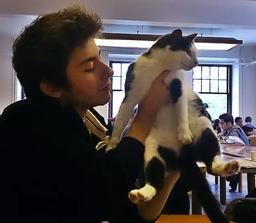The present continuous is used to describe an action that is currently going on. To form the present continuous of a verb, do the following:
- Find the stem by dropping mEk from the end of the verb.
- If the last letter of the stem is a vowel, drop it.
- Add the ending for the present continuous, depending on the person who is performing the action.
| Singular | Plural | |
|---|---|---|
| First person | İyorum | İyoruz |
| Second person | İyorsun | İyorsunuz |
| Third person | İyor | İyor(lar) |
The lar ending is optional for animate beings and is not used for objects. The lar ending is most often used when the subjects are humans.
| The books are falling. | Kitaplar düşüyor. |
| The cats are falling. | Kediler düşüyor(lar). |
| The children are falling. | Çocuklar düşüyor(lar). |
See the table below for a reminder of how to replace İ according to major vowel harmony.
| If the last vowel after step 2 is | i or e | ı or a | u or o | ü or ö |
| replace İ by | i | ı | u | ü |
Below are some examples for creating the present continuous:
| English | Infinitive | Stem | Drop trailing vowel | Personal ending |
|---|---|---|---|---|
| I am walking. | yürümek | yürü | yür | Yürüyorum. |
| You are drinking. | içmek | iç | iç | İçiyorsun. |
| She is saying. | söylemek | söyle | söyl | Söylüyor. |
| We are selling. | satmak | sat | sat | Satıyoruz. |
| You are sitting. | oturmak | otur | otur | Oturuyorsunuz. |
| They are reading. | okumak | oku | ok | Okuyor(lar). |
As you can see, we can make sentences in Turkish without using the personal pronouns ben, sen, etc. If we do use personal pronouns, extra emphasis is added to the person performing the action.
With the verbs demek and yemek, there is no vowel left after taking the stem and dropping the trailing vowel. In this case, we use the vowel i.
| English | Infinitive | Stem | Drop trailing vowel | Personal ending |
|---|---|---|---|---|
| I am saying. | demek | de | d | Diyorum. |
| You are eating. | yemek | ye | y | Yiyorsun. |

